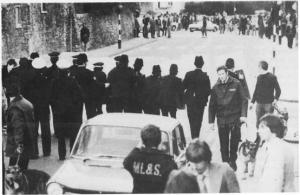 W
WThe St Pauls riot occurred in St Pauls, Bristol, England on 2 April 1980 when police raided the Black and White Café on Grosvenor Road in the heart of the area. After several hours of disturbance in which fire engines and police cars were damaged, 130 people were arrested, 25 were taken to hospital, including 19 police and members of the press.
 W
WThe second Handsworth riots took place in the Handsworth district of Birmingham, West Midlands, from 9 to 11 September 1985. The riots were reportedly sparked by the arrest of a man near the Acapulco Cafe, Lozells and a police raid on the Villa Cross public house in the same area. Hundreds of people attacked police and property, looting and smashing, even setting off fire bombs.
 W
WThe African and Caribbean War Memorial in Brixton, London, is the United Kingdom's national memorial to African and Caribbean service personnel who fought in the First and Second World Wars. It originated with a project for a memorial to Caribbean Royal Air Force veterans of World War II who arrived in Britain in 1948 on the MV Empire Windrush; this was an extension of the commemorative plaque and sculpture scheme run by the Nubian Jak Community Trust to highlight the historic contributions of Black and minority ethnic people in Britain. The memorial was originally to have been placed at Tilbury Docks, as part of the commemoration for the centenary of the outbreak of World War I. However, as the project began to evolve into a larger tribute that included both World Wars and commemorated servicemen and women from both Africa and the Caribbean, it was agreed by the memorial recipient – the Port of Tilbury – and the project organisers that a new, more accessible location needed to found. The memorial was ultimately permanently installed and unveiled on 22 June 2017 in Windrush Square, Brixton.
 W
W W
WThe Atlantic slave trade, transatlantic slave trade, or Euro-American slave trade involved the transportation by slave traders of various enslaved African people, mainly to the Americas. The slave trade regularly used the triangular trade route and its Middle Passage, and existed from the 16th to the 19th centuries. The vast majority of those who were enslaved and transported in the transatlantic slave trade were people from Central and West Africa, who had been sold by other West Africans, or by half-European "merchant princes" to Western European slave traders, who brought them to the Americas. Except for the Portuguese, European slave traders generally did not participate in the raids because life expectancy for Europeans in sub-Saharan Africa was less than one year during the period of the slave trade. The South Atlantic and Caribbean economies were particularly dependent on labour for the production of sugarcane and other commodities. This was viewed as crucial by those Western European states that, in the late 17th and 18th centuries, were vying with each other to create overseas empires.
 W
WAutograph ABP is a British-based international, non-profit-making, photographic arts agency.
 W
WDido Elizabeth Belle was a British heiress and a member of the Lindsay family of Evelix. She was born into slavery; her mother, Maria Belle, was an African slave in the British West Indies. Her father was Sir John Lindsay, a British career naval officer who was stationed there. Her father was knighted and promoted to admiral. Lindsay took Belle with him when he returned to England in 1765, entrusting her raising to his uncle William Murray, 1st Earl of Mansfield, and his wife Elizabeth Murray, Countess of Mansfield. The Murrays educated Belle, bringing her up as a free gentlewoman at their Kenwood House, together with another great-niece, Lady Elizabeth Murray, whose mother had died. Lady Elizabeth and Belle were second cousins. Belle lived there for 30 years. In his will of 1793, Lord Mansfield conferred her freedom and provided an outright sum and an annuity to her, making her an heiress.
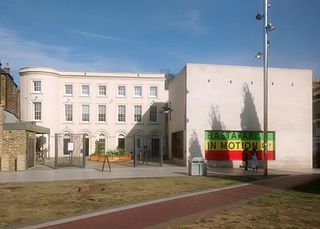 W
WBlack Cultural Archives (BCA) was founded in 1981, by educationalist and historian Len Garrison and others. BCA's mission is to record, preserve and celebrate the history of people of African descent in Britain. The BCA's new building in Brixton, opened in 2014, enables access to the archive collection, provides dedicated learning spaces and mounts a programme of exhibitions and events.
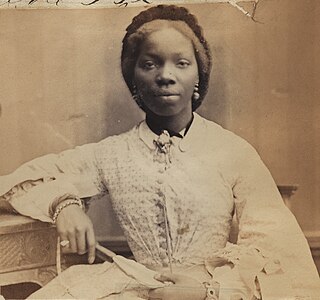 W
WSara Forbes Bonetta,, was an Egbado princess of the Yoruba people in West Africa who was orphaned during a war with the nearby Kingdom of Dahomey and later became the slave of King Ghezo of Dahomey. In a remarkable twist of events, she was liberated from slavery by Captain Frederick E. Forbes of the British Royal Navy and became a goddaughter to Queen Victoria. She was married to Captain James Pinson Labulo Davies, a wealthy Lagos philanthropist.
 W
WThe Breakdown was a 1926 painting by Scottish artist John Bulloch Souter (1890–1972) which stirred controversy in the United Kingdom during the Jazz Age. The work depicted a black jazz musician playing the saxophone while a naked white woman dances, as if in a trance.
 W
WThe Bristol Bus Boycott of 1963 arose from the refusal of the Bristol Omnibus Company to employ Black or Asian bus crews in the city of Bristol, England. In line with many other British cities at the time, there was widespread racial discrimination in housing and employment against so-called "Coloureds". An organisation founded by Roy Hackett and led by youth worker Paul Stephenson as the spokesperson of the group which included Owen Henry, Audley Evans, Prince Brown and Guy Bailey and the West Indian Development Council, the boycott of the company's buses by Bristolians lasted for four months until the company backed down and overturned their discriminative colour bar policy.
 W
WThe 1981 Brixton riot, or Brixton uprising, was a confrontation between the Metropolitan Police and protesters in Brixton, South London, England, between 10 and 12 April 1981. The main riot on 11 April, dubbed "Bloody Saturday" by Time magazine, resulted in 279 injuries to police and 45 injuries to members of the public; over a hundred vehicles were burned, including 56 police vehicles; almost 150 buildings were damaged, with thirty burned. There were 82 arrests. Reports suggested that up to 5,000 people were involved.
 W
WThe Broadwater Farm riot occurred on the Broadwater council estate in Tottenham, North London, on 6 October 1985.
 W
WAnthony George Charles was a boxer, commonly known as Dixie Brown. He worked on the construction of the Panama Canal and emigrated to Cardiff, Wales in 1919. In the West Country of England, he survived by working as a bare-knuckle boxer in fairground booths. He moved with his wife, Lily Sellick, to Bristol in 1923, and registered as a professional boxer, fighting 85 bouts in the 1920s and 1930s, as welterweight and middleweight. He trained at the White Horse in Milk Street. He could not contest any British championships owing to the colour bar then in operation. He had two wins, both over one-time champion Billy Green, five losses and two draws in his professional career.
 W
WSir George Bruce of Carnock was a Scottish merchant and engineer.
 W
WThe Buxton Memorial Fountain is a memorial and drinking fountain in London, the United Kingdom, that commemorates the emancipation of slaves in the British Empire in 1834, and in particular, the role of British parliamentarians in the abolition campaign.
 W
WThe Committee for the Relief of the Black Poor was a charitable organisation founded London in 1786 to provide sustenance for distressed people of African and Asian origin. It played a crucial role in the proposal to form a colony for black refugees in Sierra Leone. The work of the Committee overlapped to some extent with the campaign to abolish slavery throughout the British Empire.
 W
WWilliam Cuffay was a Chartist leader in early Victorian London.
 W
WDarnaway Castle, also known as Tarnaway Castle, is located in Darnaway Forest, 3 miles (4.8 km) southwest of Forres in Moray, Scotland. This was Comyn land, given to Thomas Randolph along with the Earldom of Moray by King Robert I. The castle has remained the seat of the Earls of Moray ever since. Rebuilt in 1810, it retains the old banqueting hall, capable of accommodating 1,000 men.
William Davidson was a British African-Caribbean radical executed for his role in the Cato Street Conspiracy against Lord Liverpool's government in 1820.
 W
WDropmore Park is a private estate located along Dropmore Road, north of Burnham, Buckinghamshire, England, about 220 acres (89 ha) in size. The park with its buildings, including Dropmore House, have Grade I listed building status. Dropmore House is one of the most important buildings in south Buckinghamshire.
 W
WHMT Empire Windrush, originally MV Monte Rosa, was a passenger liner and cruise ship launched in Germany in 1930. She was owned and operated by the German shipping line Hamburg Süd in the 1930s under the name Monte Rosa. During World War II she was operated by the German navy as a troopship. At the end of the war, she was taken by the British Government as a prize of war and renamed the Empire Windrush. In British service, she continued to be used as a troopship until March 1954, when the vessel caught fire and sank in the Mediterranean Sea with the loss of four crew. H.M.T. stands for 'His Majesty's Transport’ and M.V. for 'Motor Vessel’.
 W
WIn May 1590, Anne of Denmark was crowned queen consort of Scotland. There was also a ceremony of joyous entry into Edinburgh, an opportunity for spectacle and theatre and allegorical tableaux promoting civic and national identities, similar in many respects to those performed in many other European towns. Celebrations for the arrival of Anne of Denmark in Scotland had been planned and prepared for September 1589, when it was expected she would sail from Denmark with the admirals Peder Munk and Henrik Gyldenstierne. She was delayed by accidents and poor weather and James VI of Scotland joined her in Norway in November. They returned to Scotland in May 1590.
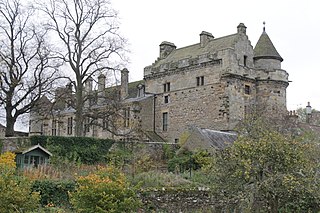 W
WFalkland Palace, in Falkland, Fife, Scotland, is a royal palace of the Scottish Kings. Today it is under the stewardship of Ninian Stuart, who delegates most of his duties to The National Trust for Scotland.
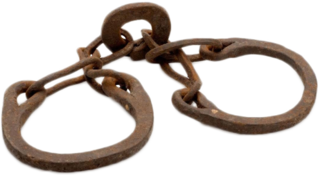 W
WThe Igbo, whose traditional territory is called the Bight of Biafra, became one of the principal ethnic groups to be enslaved during the Trans-Atlantic Slave Trade. An estimated 14.6% of all slaves were taken from the Bight of Biafra between 1650 and 1900. The Bight’s major slave trading ports were located in Bonny and Calabar. The majority of Igbo slaves were kidnapped during village raids. The journey for Igbo slaves often began in the ancient Cave Temple that was located in Arochukwu Kingdom. During this period, the three Igbo Kingdoms followed the same culture and religion, yet tended to operate very differently from each other. The Kingdom of Nri and the Independent Igbo States did not practice slavery, and slaves from neighbouring lands would often flee to these kingdoms in order to be set free. Arochukwu, on the other hand, practiced a system of indentured servitude that was remarkably different to chattel slavery in the Americas. Eventually, with Europeans beginning to encroach on Igbo territory, causing the kingdoms to desire weaponry to defend themselves. In order to obtain European goods and weaponry, Arochukwu began to raid villages of the other Igbo kingdoms - primarily those located in the Igbo hinterlands. People would be captured, regardless of gender, social status, or age. Slaves could have been originally farmers, nobility, or even people who had committed petty crimes. These captured slaves would be taken and sold to the British on the coast. Another way people were enslaved was through the divine oracle who resided in the Cave Temple complex. All Igbos practiced divination called Afa, but the Kingdom of Arochukwu was different because it was headed by a divine oracle who was in charge of making decisions for the king. During this time, if someone committed a crime, was in debt, or did something considered an "abomination", they would be taken to the cave complex to face the oracle for sentencing. The oracle, who was also influenced by the British, would sentence these people to slavery, even for small crimes. The victim would be commanded to walk further into the cave so that the spirits could "devour" them, but, in reality, they were taken to an opening on the other side and loaded directly onto a waiting boat. This boat would take them to a slave ship en route to the Americas.
 W
WHenry or Henrie Anthonie Jetto was a black English yeoman, the earliest-known black person with an extant will in England and the earliest to have resided in Worcestershire.
 W
WScipio Kennedy was a slave taken as a child from Guinea in West Africa. After being purchased at the age of five or six by Captain Andrew Douglas of Mains, he served as a slave under his daughter, Jean, wife of Sir John Kennedy, 2nd Baronet of Culzean in Ayrshire. He was granted a manumission in 1725, but continued to work for the Kennedy family and was given land on the estate. He married in 1728 and had at least eight children. At least one living descendant is known from the West of Scotland and has published the story of his ancestor in a Scottish national newspaper.
 W
WDoreen Delceita Lawrence, Baroness Lawrence of Clarendon, OBE is a British Jamaican campaigner and the mother of Stephen Lawrence, a black British teenager who was murdered in an attack in South East London in 1993. She promoted reforms of the police service and founded the Stephen Lawrence Charitable Trust. She was appointed to the Order of the British Empire for "services to community relations" in 2003; Lawrence was created a Life Peer in 2013. She served as Chancellor of De Montfort University, Leicester from January 2016 to January 2020.
 W
WThe Len Cantello Testimonial Match,, was a testimonial football match that took place in May 1979 to celebrate West Bromwich Albion player Len Cantello, who played for the club over 300 times between 1968 and 1979. The teams were selected based on the colour of the players' skin. The West Bromwich Albion XI was composed of white players while the Cyrille Regis & Laurie Cunningham XI was composed of black players.
 W
WWilliam Murray, 1st Earl of Mansfield, PC, SL was a British barrister, politician and judge noted for his reform of English law. Born to Scottish nobility, he was educated in Perth, Scotland, before moving to London at the age of 13 to take up a place at Westminster School. He was accepted into Christ Church, Oxford, in May 1723, and graduated four years later. Returning to London from Oxford, he was called to the Bar by Lincoln's Inn on 23 November 1730, and quickly gained a reputation as an excellent barrister.
 W
WOrlando Martins was a pioneering Yoruba Nigerian film and stage actor In the late 1940s, he was one of Britain's most prominent and leading black actors, and in a poll conducted in 1947, he was listed among Britain's top 15 favourite actors.
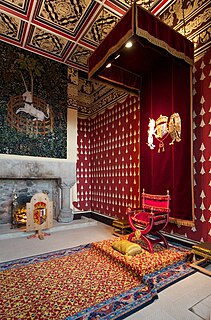 W
WThe Masque at the baptism of Prince Henry, was a celebration at the christening of Prince Henry at Stirling Castle, written by the Scottish poet William Fowler and Patrick Leslie, 1st Lord Lindores.
 W
WThe Memorial Gates are a war memorial located at the Hyde Park Corner end of Constitution Hill in London. Also known as the Commonwealth Memorial Gates, they commemorate the armed forces of the British Empire from five regions of the Indian subcontinent, as well as Africa and the Caribbean, who served for Britain in the First and Second World Wars.
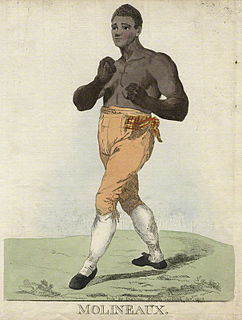 W
WThomas "Tom" Molineaux, sometimes spelled Molyneaux, was an African-American bare-knuckle boxer and possibly a former slave. He spent much of his career in Great Britain and Ireland, where he had some notable successes. He arrived in England in 1809 and started his fighting career there in 1810. It was his two fights against Tom Cribb, widely viewed as the Champion of England, that brought fame to Molineaux, although he lost both contests. The result of the first encounter was hotly contested, with accusations of a fix. The second, losing contest with Cribb, however, was undisputed. His prizefighting career ended in 1815. After a tour that took him to Scotland and Ireland, he died in Galway, Ireland in 1818, aged 34.
 W
WEllen or Elen More was an African servant at the Scottish court.
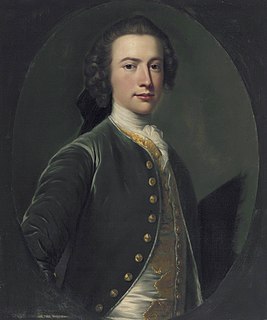 W
WValentine Morris was a British landowner and politician, responsible for developing the picturesque woodland walks at Piercefield in the Wye Valley, and the Governor of St. Vincent from 1772 to 1779.
 W
WJohn Mosman was an apothecary at the Scottish court.
 W
WJohn Naimbanna (17??–1793) was a Temne Prince who visited London in 1791–1793.
 W
W"Of Ane Blak-Moir" is a short poem in Scots by William Dunbar.
 W
WDavid Oluwale (1930–1969) was a British Nigerian who drowned in the River Aire in Leeds, West Riding of Yorkshire, in 1969. The events leading to his drowning have been described as "the physical and psychological destruction of a homeless, black man whose brutal, systematic harassment was orchestrated by the Leeds city police force." Oluwale's death resulted in the first successful prosecution of British police officers for involvement in the death of a black person. The precise sequence of events that led to Oluwale entering the river—whether he was deliberately thrown, chased or fell accidentally—have never been officially established, although two independent witnesses testified that they saw uniformed police officers chasing him alongside the river on the night he is believed to have drowned.
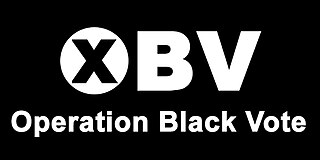 W
WOperation Black Vote (OBV) is non-partisan and not-for-profit national organisation that was established in 1996 to address the Black British and ethnic minority democratic deficit. Focusing on voter registration, lobbying politicians and mentoring schemes, OBV aims to inspire black and minority ethnic communities to engage with public institutions to address the perceived race inequalities in areas including education, health and employment.
 W
WThe Park Street riot occurred in Park Street and George Street Bristol, England, on 15 July 1944 when many black US servicemen (GIs) refused to return to their camps after US military policemen (MPs) arrived to end a minor fracas. More MPs were sent, up to 120 in total, and Park Street was closed with buses. In subsequent confrontations an MP was stabbed, a black GI was shot dead, and several others were wounded.
 W
WCaptain John Perkins, nicknamed Jack Punch, was a British Royal Navy officer. Perkins was perhaps the first mulatto commissioned officer in the Royal Navy. He rose from obscurity to be one of the most successful ship captains of the Georgian navy. He captained a 10-gun schooner during the American War of Independence and in a two-year period captured at least 315 enemy ships.
 W
WThe Race Relations Act 1965 was the first legislation in the United Kingdom to address racial discrimination.
 W
WCharles Ignatius Sancho was a British abolitionist, writer and composer. Born on a slave ship in the Atlantic, Sancho was sold into slavery in the Spanish colony of New Grenada. After his parents died, Sancho's owner took the two-year-old orphan to England and gifted him to three Greenwich sisters, where he remained their slave for eighteen years. Unable to bear being a servant to them, Sancho ran away to the Montagu House, whose owner had taught him how to read and encouraged Sancho's budding interest in literature. After spending some time as a servant in the household, Sancho left and started his own business as a shopkeeper, while also starting to write and publish various essays, plays and books.
 W
WAgnes Yewande Savage was a Nigerian doctor and the first West African woman to train and qualify in orthodox medicine. Savage was the first West African woman to receive a university degree in Medicine, graduating with first-class honours from the University of Edinburgh in 1929 at the age of 23. In 1933, Sierra Leonean political activist and higher education pioneer, Edna Elliott-Horton became the second West African woman university graduate and the first to earn a bachelor's degree in the liberal arts.
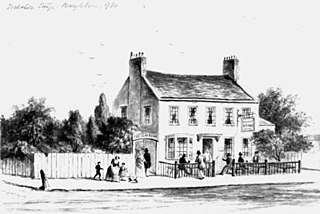 W
WThe Yorkshire Stingo was a public house in Marylebone in the 18th and 19th centuries, and served as a significant landmark just outside central London.
 W
WJohn Ystumllyn, also colloquially known as Jac Du or Jack Black, was an 18th-century Welsh gardener and the first well-recorded black person of North Wales.